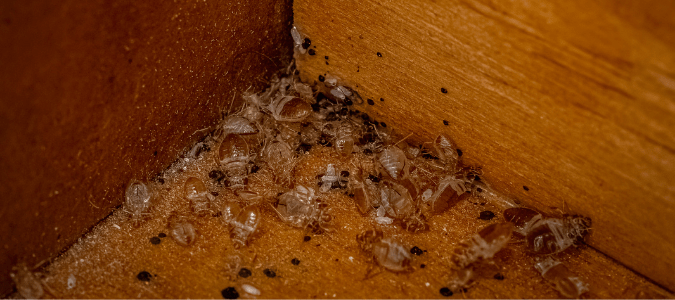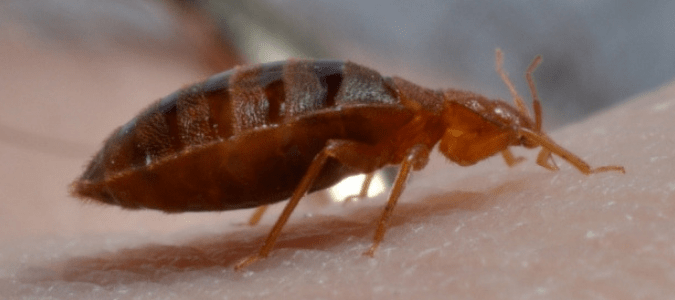Bed bugs…just thinking about them is enough to make most folks itchy. Cimex lectularius, or bed bugs, are small insects, about the size of an apple seed. Typically, they are brown in color with a flat and oval shape. Like ticks, bed bugs are parasites. They feed on blood and can swell to considerably larger sizes when feeding, which can last up to ten minutes.
Part of what makes these pests difficult to eradicate is their ability to go months at a time without feeding. In the right conditions, bed bugs can go for months without a meal. Additionally, these pests have become resilient to many of the products on the market. To make matter worse, females can lay hundreds of eggs over their lifetime. And, they begin reproducing after only a month, laying eggs three or more times per year.
If you think you may be dealing with bed bugs, look for these signs:
- Rusty or reddish-brown spots on bed sheets caused by bed bugs being crushed.
- Dark spots on your bedding or mattress that may bleed on fabric like a marker would. This is bed bug feces.
- Bed bug eggs, which are tiny and white and typically laid in mattress seams.
- Live bed bugs.
- Bed bug casings or shells.
What Are Bed Bug Casings?
Casings is another word used for the bed bug’s shell, specifically once it’s been shed. Bed bugs, like many other insects, have their skeletons on the exterior or encasing their body. Referred to as an exoskeleton, this “casing” must be shed periodically as the insect matures and outgrows it.
Following mating, the female bed buy will lay between one and five eggs per day each of which forms into a nymph and hatches in around 10 days. The shell of the egg left behind after hatching is the nymph’s first casing.
Bed bug nymphs grow through five stages before reaching adulthood and each transition must be preceded by a meal of fresh blood. The nymph leaves behind its casing at the end of each stage. Once it reaches adulthood, it stops growing in size and no longer needs to shed its exoskeleton. So, any casings you may find are being left behind by nymphs in various stages of their growth cycle.
The stage of the nymph can be determined by the size of its casing:
- 1st stage nymphs are roughly 1.5 mm long
- 2nd stage nymphs are roughly 2mm (about the size of a pinhead)
- 3rd stage nymphs are roughly 2.5 mm
- 4th stage nymphs are roughly 3mm
- The 5th and final stage is around 4.5mm
After a shell has been shed at each stage, the baby bed bug will look darker and darker. Once the bed bug has reached maturity, it will be a dark reddish-brown.
Where to Look for Bed Bug Casings
Bed bugs tend to stay in groups so, the larger the infestation, the more bed bug casings will be left behind and the easier they’ll be to find.
The most likely location to find bed bug casings is in and around sleeping areas, especially in the seams, folds, and crevices of mattresses or box springs, or behind headboards. Don’t let the bed bug’s name fool you, however, as there’s just as good a chance that they’re lurking in other spots as well, like:
- Furniture
- Clothes
- Items stored under beds
- Upholstered chairs, recliners or sofas
- Cracks or crevices in wood molding
- Ceiling-wall junctures
- Behind wall-mounted objects (pictures, mirrors, switch, outlet cover; etc.)
- Under loose wallpaper
- In bookbindings
Bed bugs can even live inside clocks, TVs and smoke detectors!
A common misunderstanding is that a home or building that hosts bed bugs must be dirty or even filthy, but this is not the case. Bed bugs are just as likely to be found in immaculate hotel rooms that are cleaned every day, as they are in the average home. If bed bugs end up in your home, your best option is to contact a pest control professional. They can create the most effective pest treatment plan for your particular problem.
Do Bed Bugs Bite Through Clothes?
Bed bugs prefer to feed at night, typically seeking out an easy meal from people who are asleep. If food is scarce and they get particularly hungry though, they will feed during the day, especially in dimly lit environments.
Bed bugs cannot bite through clothing, as their mouths aren’t long or strong enough to penetrate fabric and still reach the skin beneath. This is why they typically bite exposed skin, such as hands, necks, arms and shoulders.
Bed Bug Bites
Before feeding, the bed bug will inject a blood-thinning chemical into the bite site. This both numbs it and keeps the blood from coagulating until after the bug has finished its meal. The human immune system tends to react to this chemical with a red, irritated bump on the skin that can itch for several days.
Often, bed bugs will bite several times in a straight line, especially up and down its victim’s arms or legs. This can result in elongated, spindle-shaped welts that help distinguish the bed bug bites from the bites of other insects like fleas, mosquitoes or spiders.
An adult bed bug, if left undisturbed, can feed for up to 15 minutes before becoming too engorged to draw any more blood. Once full, the critter will find an out-of-the-way hiding space to where it will rest for several days while digesting its meal. Only after it has exhausted its current supply of blood will it venture out on another hunting expedition.
There can be a dozen or more bites clustered together and only noticed 45 to 60 minutes afterward when the natural analgesic wears off. Common effects of bed bug bites also include allergy symptoms similar to the common cold.
Living in groups, bed bugs tend to prefer mattresses and box springs for easy access to their favorite meal…us!
Bed bug bites often go unnoticed depending on the severity of individual reactions. Reactions can range from severe swelling, itching and welts, to no noticeable reaction at all. The transmission of disease from bed bug bites is extremely rare. Mild antihistamines or corticosteroids may be prescribed in severe reactions, along with antiseptic or antibiotic ointments to prevent infection. These are usually enough to handle these symptoms in the majority of cases.
The best way to deal with these pests and the bites that come with them is to contact a professional. They will be able to create a custom pest control plan, so you and your family can be comfortable again.
Why Do I Have Bed Bugs?
Bedbugs, which were the scourge of many a homeowner before the widespread distribution of DDT following WWII, became less and less of a problem in the decades following, especially in more developed countries. Then, in 1972 the EPA issued a cancelation order for DDT due to its adverse environmental effects. Ever since populations of bed bugs have been on the rise.
This has been a growing issue, particularly in the hotel and lodging industry.
Unfortunately, the bed bug is an opportunistic traveler. One or two picked up in a motel, hotel or from public transportation will happily tag along to their unknowing host’s destination.
Clothing and luggage are two of the bed bug’s most frequent means of transportation. They are often carried home and conveniently brought directly to the very rooms that they would have sought out on their own. In fact, the rise in international travel may have been the single highest contributor to the resurgence of bed bug populations both in the U.S. and abroad.
The Best Way to Deal With Bed Bugs
If you’ve discovered bed bug casings or other tell-tale signs of bedbugs in your home, the chances are good that you have a previously undiscovered infestation as bed bugs seldom, if ever, just go away on their own.
You’re probably wondering what you can do it evict these unwelcome intruders. The truth is that most folks don’t even realize that they have a bed bug issue for at least several days. Unfortunately, this gives them plenty of time to establish a population in a home.
Knowing where to look is another critical skill, as is knowing how to avoid the risk of re-infestation. When it comes to bedbugs, perhaps more than any other pest, it’s critical to know how to get them all.
There’s no “close enough” with these creepie-crawlies!
A professional exterminator can formulate a targeted plan of treatment (using professional-grade products and equipment), locate the source(s) of your bed bug infestation, and, relying on their training and experience, maximize the impact of the treatment.
They can also provide you with the best and most up-to-date information on how to avoid reinfestations in the future. Professionals are the fastest, easiest and most effective method to eliminate bed bugs.
ABC Can Eliminate the Bed Bugs in Your Home
Dealing with a bed bug infestation can be scary and exhausting. At the first sign of bed bugs and their casings, contact ABC Home & Commercial Services. Our professionals have a variety of tools they can use to treat these pests. This way, you and your family can sleep easy again.



